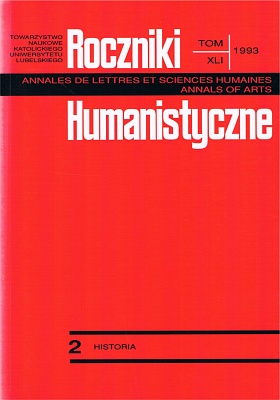The Foundations According to German Law In Cruda Radice in the Southern Part of the Cracow Voivodship During 1334-1434
Abstract
In the present paper we have studied the development of settlements according to German law in cruda radic e in the southern part of the Cracow voivodship in three administrative districts: the Biec z, the Sącz, and the Szczyrzyce districts during 1334-1434. The paper is in a sense a continuation of the research started by A. Gąsiorowski.
Our main interest was a chronology of the establishment of towns and villages, their territorial location and the owners of estates. These owners were most interested in setting up new settlements in their estates.
We have also presented the privileges and duties of v illa g e administrators as well as people’s services. We have pointed to the territorial origin of village administrators, leaving to the side as an open matter their ethnic origin. While talking about German law in cruda radice, one cannot omit the period of tax exemption which was closely linked with this law.
In 200 localities set up according to the so-called German law 72 were located on the raw root, which made 36 per cent of all foundations. If we add to this figure 21 settlements extended as a result of gaining new areas for agriculture, then we get the total of 93 localitie s (almost a half). They were not only endowed with a new social-economical system, but also contributed to the increase in new settlements and the enlargement of arable land.
On the basis of sources we have proved that new villages were set up mainly in forest areas, which had not been brought into cultivation before. Most settlements of this type were established in the Biecz administrative district, at the territory of the borderland forest - 33, in the Sącz administrative district - 22, and in the Szczyrzyce administrative district - 17.
The kings were most interested in the development of settlements. Casimir the Great was the most prominent among them (he founded 44 new localities). The largest number of villages and all towns were set up within the royal (57), much less within the private and monastery estates (7 and 6). The bishops, however, were not interested in introducing a new system into their estates. There are only, the sources have it, two foundations of this kind.
A characteristic system of the settlement at new grounds was a 2 0 -year-long period of tax exemption. We find the latter in 42 out of 72 founded localities. In 7 villages set up in 1409 in the mountainous regions their inhabitants were exempted from any services for the period of 22 years. In the remaining cases, however, the periods of exemption were shorter and lasted from 4 to 18 years.
After the time of exemption the settlers were obliged to bear the burden of taxation for the sake of the court, the Church and the State. In the documents we most often find data about the annual rent paid for the sake of the settlement’s owner (8 skojcow per feud) and money and maldratowy tithes given to a bishop (most often in money - one ferton, and in corn - one measure of rye, oat and wheat.
The data do not reflect, however, the actual relations which were at work at the territory in question. Rather, they reflect a process in its origin whose fragmented character did not allow for any reliable recreation of the course of urban and rural foundation in cruda radice. However, the above figures may be treated as an indicators of the intensity of settlement action.
Copyright (c) 1993 Roczniki Humanistyczne

This work is licensed under a Creative Commons Attribution-NonCommercial-NoDerivatives 4.0 International License.





